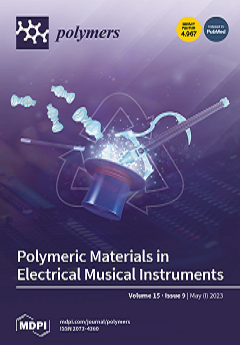In this work, a synthesis technique for highly homogeneous PVDF-CaFe
2O
4 polymer films direct from solution was developed. The structural characterizations were conducted using XRD, FTIR, and ESEM experimental techniques. The XRD characteristic peaks of CaFe
2O
4 nanoparticles revealed
[...] Read more.
In this work, a synthesis technique for highly homogeneous PVDF-CaFe
2O
4 polymer films direct from solution was developed. The structural characterizations were conducted using XRD, FTIR, and ESEM experimental techniques. The XRD characteristic peaks of CaFe
2O
4 nanoparticles revealed a polycrystalline structure. The average crystallite size for CaFe
2O
4 was calculated to be 17.0 nm. ESEM micrographs of PVDF nanocomposites containing 0.0, 0.25, 0.75, and 1.0 wt% of CaFe
2O
4 showed smooth surface topography. The direct E
dir and indirect E
ind band gap energies for the PVDF-CaFe
2O
4 nanocomposites were decreased with the additions of 0.0–1.0 wt% CaFe
2O
4. In addition, the refractive index (
n0) increased from 3.38 to 10.36, and energy gaps (E
g) decreased from 5.50 to 4.95 eV. The nonlinear refractive index (n
2) for the PVDF-CaFe
2O
4 nanocomposites was improved with the addition of CaFe
2O
4 nanoparticles, exceeding those reported in the literature for PVC, PVA, and PMMA nanocomposites. Therefore, the PVDF-CaFe
2O
4 nanocomposites are expected to take the lead in optoelectronic applications because of their unusual optical properties.
Full article






